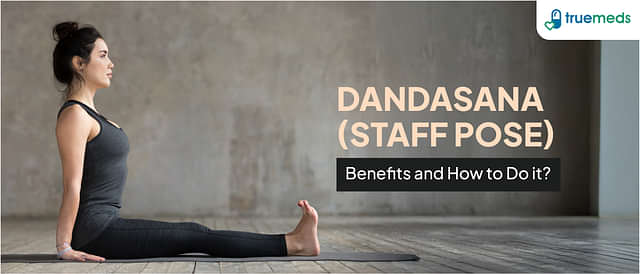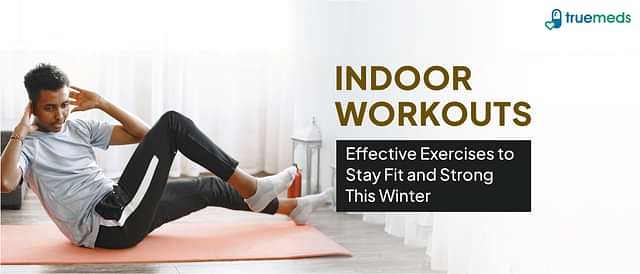Padmasana (Lotus Position): Types, Step-by-Step Guide, Benefits and Precautions
Last updated on : 01 Dec, 2025
Read time : 9 min
What is Padmasana?
Padmasana, or Lotus Pose, is a classical seated yoga posture that promotes mindfulness, strengthens the spine, and improves flexibility. Rooted in ancient yogic tradition, this meditative posture offers physical, mental, and spiritual benefits, making it a cornerstone for both beginners and advanced practitioners. Whether you’re looking to reduce stress, improve posture, or deepen your breathwork, practicing Padmasana with proper alignment can be a transformative addition to your routine.
Key Benefits of Padmasana
The consistent, safe practice of the Lotus Pose may contribute to the following holistic benefits:
Strengthens and Improves Joint Mobility
Padmasana gently targets the knees, ankles, and hips, helping to improve the flexibility of these major joints. Regular practice helps to lengthen the spine, promoting better posture while gently stimulating the muscles of the lower body [1].
Enhances Breathing Capacity
Practising rhythmic breathing patterns (Pranayama) while in Padmasana, especially in variations, may support deep inhales and exhales, potentially improving your lung capacity [1].
Boosts Focus and Concentration
One significant benefit of this pose is improving concentration. The stability of the seated position calms the nervous system and enhances your focus, preparing you for deeper meditative states.
Supports Spinal Health
Padmasana encourages steady spinal alignment, which helps to balance and revitalise the body’s energy.
Promotes Relaxation in the Lower Body
The interlocking of legs during Padmasana is believed by some traditions to stimulate acupuncture points, activating the parasympathetic nervous system, which may help calm the nervous system overall [2].
May Aid in Managing High Blood Pressure
Preliminary research suggests that regular practice of Padmasana, when combined with slow, deep breathing, may contribute to a reduction in resting heart rate and blood pressure [1].
Supports Digestive Function
Padmasana gently compresses the abdominal area, which may improve blood flow to digestive organs and help stimulate the digestive system.
Improves Sleep Quality
This pose has a calming effect on the mind that may help combat insomnia. Regular, mindful practice can support better sleep patterns.
Reduces Stress and Anxiety
This pose may assist in regulating stress hormone production, providing a sense of grounding that helps manage general stress and anxiety [2].
Strengthens the Pelvic Region
This yoga pose is known for strengthening the pelvic region. It is often recommended for women as it may support reproductive organs and may help ease discomfort during menstruation or labor when performed safely under guidance. Regular practice can gently open the hip muscles.
Common Types of Padmasana for Beginners
For safe practice, beginners should always start with preparatory poses or Half Lotus Pose (Ardha Padmasana). Below are a few common variations:
Ardha Padmasana (Half Lotus Pose)
Ardha Padmasana involves placing only one foot on the opposite thigh while keeping the other on the floor. This variation gradually prepares your hips and knees for the full pose.
Scale Pose (Tolasana)
In Scale Pose, you lift both legs into a balanced position while in Padmasana, engaging the core and creating strength in the arms. This variation not only challenges your stability but also enhances focus.
Seated Mountain Pose (Parvatasana in Padmasana)
This pose involves sitting in Padmasana or Ardha Padmasana and lifting the arms overhead, similar to Tadasana but seated. This variation encourages a tall spine and promotes a sense of stability.
Half Lotus Side Bend
This variation combines the Half Lotus with a side bend. It involves gently stretching the torso sideways, enhancing flexibility in the spine and opening the chest.
Half Lotus with Props
You can modify the half lotus pose using props like a block, bolster, or cushion under the sitting bones or knees. This variation allows you to gradually ease into the pose, supporting proper alignment and comfort.
Lotus in a Chair
This is an accessible alternative for those with mobility issues, where the practitioner sits in a chair and crosses one or both ankles toward the opposite thigh without strain.
Step-by-Step Instructions to Perform Padmasana Correctly
Here’s your easy guide to practising Padmasana:
- Sit on the floor with your legs stretched out in Dandasana (Staff Pose).
- Bend your right knee and hold your knee and foot with your hands. Gently guide your right ankle and foot towards your left hip crease, ensuring the sole of the foot faces upward. The movement should originate from the hip, not the knee.
- Next, bend your left knee, turning your thigh outward. Lift your left shin, guide the left foot over the right, and tuck it into the right hip crease. The sole of your left foot should also face upward.
- Place the tops of your feet on your upper thighs and gently allow your knees to move towards the floor. Do not force the knees down. Keep your ankles from rolling inward.
- Sit up straight, lift your chest, and lengthen your spine. Sitting on a folded blanket or block can help your spine stay straight.
- Breathe slowly and deeply, and stay in this position as long as you feel comfortable, without experiencing pain in the knees or ankles.
Who Should Avoid Padmasana? Key Precautions
Padmasana is an advanced hip-opening pose and must be approached with caution.
Do not attempt this pose if you have:
- Knee or Ankle Injury/Surgery: Padmasana puts significant rotational stress on the knee and ankle joints. Individuals with pre-existing injuries, tears, or recent surgeries in these areas must avoid the pose entirely.
- Sciatica or Lower Back Issues: Individuals experiencing active sciatica or severe lower back pain should avoid the Padmasana pose, as the deep hip flexion may exacerbate nerve pain.
- Arthritis: Individuals with osteoarthritis or rheumatoid arthritis, particularly in the knees or hips, should skip this pose, as the pressure can be harmful.
- Pregnancy with Complications: Pregnant women with unstable pelvic joints (e.g., symphysis pubis dysfunction), back pain, or swollen ankles should skip the full Lotus Pose.
- Limited Flexibility: If you are older or just starting and your knees, ankles, or lower back feel tight, do not force the pose. This can cause severe joint damage.
If your physical issues are minor or you are new to the pose, try the Half Lotus Pose (Ardha Padmasana) or use props for modification and comfort, and always consult a certified yoga instructor.
Expert Tips for Practising Padmasana Safely
Prioritize Hip Flexibility
Getting into Lotus Pose needs flexible hips, not just flexible knees. Focus on preparatory hip-opening poses like Baddha Konasana (Bound Angle Pose) or Virasana (Hero Pose) before attempting Padmasana.
Protect Your Knees
Never forcefully push your feet into the position. A sharp sensation or pain in the knee is a critical warning sign to immediately exit the pose. The sensation should be in the hip and thigh, not the knee.
Ensure Balanced Stretching
When bringing your foot close to your groin, ensure your inner and outer ankles stretch evenly. Avoid straining one side more than the other.
Switch Leg Crossing
To maintain hip balance and prevent asymmetry, alternate which leg you cross first. A simple practice is to start with the right leg on even days and the left leg on odd days.
Use Props and Seek Guidance
Use supportive props, such as sitting on a cushion or a block, to elevate your hips. Always take the help of a certified yoga instructor to guide you through safe alignment.
Practice Counterposes
Always practice counterposes after Padmasana to neutralise the body and release tension from the joints. Recommended counterposes include Paschimottanasana (Seated Forward Fold), Adho Mukha Svanasana (Downward-Facing Dog), and Savasana (Corpse Pose).
Takeaway
Padmasana is a deeply grounding yoga pose that enhances flexibility, posture, and mental clarity. Practising mindfully and safely prepares your body for meditation and advanced yoga asanas. However, due to the high risk of knee injury, if you’re recovering from an injury, pregnant, or managing arthritis or joint pain, always consult a yoga therapist or healthcare provider before attempting this pose. Start with preparatory stretches and build your flexibility gradually for safe, sustainable progress.
Expert Quote
“Padmasana is much more than a meditative pose as it aligns the spine, calms the mind, and helps the body achieve a deeper state of awareness.”
-Dr Lakshmi Vaswani
Frequently Asked Questions (FAQs)
Which leg is to be placed first in Padmasana?
In Padmasana, the right leg is typically placed on the left thigh first, followed by the left leg on the right thigh, crossing the legs with both feet resting on the opposite thighs. However, it is beneficial to alternate the starting leg to maintain hip balance.
What muscles does Padmasana work?
Padmasana primarily works to stretch and open the hips, thighs, and lower back muscles. It targets the hip rotators and adductors to improve hip flexibility and promotes better posture.
What is the correct position for Padmasana?
The correct position involves sitting with a straight, tall spine; crossing the legs so both feet rest on the opposite upper thighs with soles facing up; and placing the hands on the knees in a meditation mudra. Crucially, the knees must be lower than the hips, and there should be no pain in the knees or ankles.
Who should avoid Padmasana?
Individuals with any knee or ankle injuries, hip problems, limited hip flexibility, recent surgeries, or active sciatica should avoid the full Lotus Pose. Pregnant women with complications or in advanced stages of pregnancy should also avoid this pose.
Which diseases are cured by Padmasana?
Padmasana is not a cure for any disease. It is a supportive practice that, when done correctly, may help individuals manage symptoms associated with hypertension, breathing problems, and constipation by promoting relaxation and better circulation. It should only be used to complement, not replace, medical treatment.
How much time should we sit in Padmasana?
Beginners should start with 1 to 2 minutes and gradually increase their time, listening carefully to the body. Aim for a comfortable duration without straining the knees or hips.
References
[1] Naragatti, S., & Hoskote, V. S. (2023). The profound influence of Padmasana (Lotus Pose) on an individual’s life. International Journal of Novel Research and Development, 8(9), c115–c123. https://www.researchgate.net/publication/374006001_The_Profound_Influence_of_Padmasana_Lotus_Pose_on_an_Individual
[2] Pal, K. G., Balasubramanian, B., & P., T. S. (2022). Effect of long-term yoga training on autonomic function among the healthy adults. International Journal of Yoga, 15(3), 209–213. https://pmc.ncbi.nlm.nih.gov/articles/PMC9648241/
Disclaimer
Our healthcare experts have carefully reviewed and compiled the information presented here to ensure accuracy and trustworthiness. It is important to note that this information serves as a general overview of the topic and is for informational purposes only. It is not intended to diagnose, prevent, or cure any health problem. This page does not establish a doctor-patient relationship, nor does it replace the advice or consultation of a registered medical practitioner. We recommend seeking guidance from your registered medical practitioner for any questions or concerns regarding your medical condition.
Popular Articles
Recommended Articles
Recent Articles
Company
About UsHealth ArticleHealth StoriesHealth LibraryDiseases & Health ConditionsAyurvedaUnderstanding Generic MedicinesAll MedicinesAll BrandsNeed HelpFAQSecuritySubscribe
Registered Office Address
Grievance Officer
Download Truemeds
Contact Us
Our customer representative team is available 7 days a week from 9 am - 9 pm.
v4.11.0
2026 - Truemeds | All rights reserved. Our content is for informational purposes only. See additional information.
Our Payment Partners














































